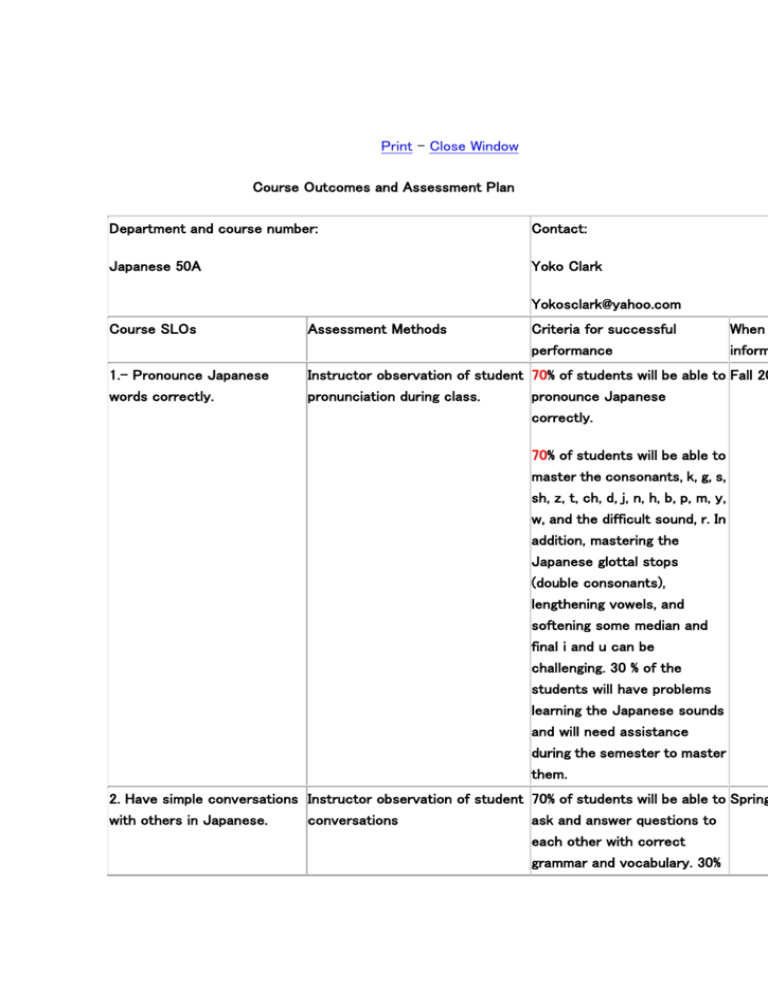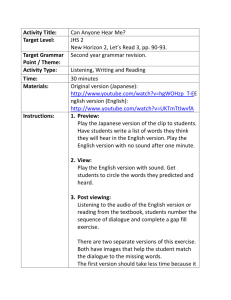Print - Close Window Course Outcomes and Assessment Plan
advertisement

Print - Close Window Course Outcomes and Assessment Plan Department and course number: Contact: Japanese 50A Yoko Clark Yokosclark@yahoo.com Course SLOs Assessment Methods Criteria for successful performance When inform 1.- Pronounce Japanese Instructor observation of student 70% of students will be able to Fall 20 words correctly. pronunciation during class. pronounce Japanese correctly. 70% of students will be able to master the consonants, k, g, s, sh, z, t, ch, d, j, n, h, b, p, m, y, w, and the difficult sound, r. In addition, mastering the Japanese glottal stops (double consonants), lengthening vowels, and softening some median and final i and u can be challenging. 30 % of the students will have problems learning the Japanese sounds and will need assistance during the semester to master them. 2. Have simple conversations Instructor observation of student 70% of students will be able to Spring with others in Japanese. conversations ask and answer questions to each other with correct grammar and vocabulary. 30% of students will need assistance from the teacher or the tutor. 3. Recognize and use basic Japanese grammar and common expressions. Analysis of written and oral tests utilizing the following grammatical concepts covered in Japanese 50A: 1. Basic copula construction— “A is B,” (negative and past inclusive). This pattern generates-Greetings, (self-(self)introduction, naming every day objects, telling and telling time. 2. Beginning polite form sentences. (negative and past inclusive) Activity verbs and Command forms. Color words. Asking for things politely. Large numbers. 60 % of students will be able Fall 20 to pass the exams with 80 / 100 points or more; 20% will receive less than 80 points and will need assistance or tutoring; 20% will fail the exams and will also need tutoring and assistance. 3. Directional verbs, time words, and means of transportation. 4. Verbs of existence. Counters, relational words, 5. “Because” construction. Family terms (respectful and humble) 6. Giving and receiving (respectful and humble) 7. “I-adjectives” and “Na-adjectives” 4. Respond appropriately to questions in Japanese. Students’ answers to questions t 50 % of students will be able to speak, ask and answer to instructors and one another-- questions, and have very simple conversations in level of complexity, speed, Japanese with correct grammar and pronunciation; appropriate vocabulary-will 25% will speak with minor mistakes; 25% will need be observed and recorded by the instructor in class. 5. Demonstrate a comprehension of and an appreciation for Japanese Observation of student reaction and appropriateness of Spring further tutoring and assistance 80% of students will show strong interest in and comprehension of Japanese culture. culture. 20% will need further Fall 20 their questions after media presentation/ lecture on aspects of Japanese culture. clarification by instructors and tutors.







